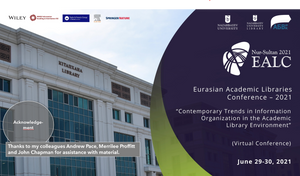Inside-out and outside-in: libraries, collections, services
I have been interested in the different dynamics of the inside-out and outside-in library for a while (see here for example). One especially interesting characteristic is the quite different approach to discovery in each case, even though this distinction has not yet crystallized in clear service categories.
I was struck by the distinction during a recent discussion of ‘discoverability’ in a publishing context, where the focus was on the active marketing of resources through a variety of channels. This is an emphasis that has not been common in a library environment, but, which, I argue here, is becoming more important. It is not enough simply to make resources available on the network; more active promotion is required if they are to be discovered.
What do I mean by outside-in and inside-out?
Throughout much of their existence, libraries have managed an outside-in range of resources: they have acquired books, journals, databases, and other materials from external sources and provided discovery systems for their local constituency over what they own or license. They aggregated scarce materials, services, and expertise close to their users. They provided a local gateway which was central to many of their users’ information lives.
The discovery focus was very much on improving a set of well-known systems that provide access to the collection (acknowledging that the library had in fact little direct influence over how access to the journal literature was presented). And this remains the main focus. This discovery apparatus has evolved, and now comprises catalog, A to Z lists, resource guides, maybe a discovery layer product, and other services. ‘Discoverability’ might be interpreted in the context of how well those systems served their users.
Network shifts
However, in a digital and network world, there have been two major changes, which shift the focus towards inside-out.
First, access and discovery have now scaled to the level of the network: they are web scale. If I want to know if a particular book exists I may look in Google Book Search or in Amazon, or in a social reading site, in a library aggregation like Worldcat, and so on. My options have multiplied and the breadth of interest of the local gateway is diminished: it provides access only to a part of what I am potentially interested in. As research and learning information resources have become abundant in this environment, the library collection and its discovery systems are no longer the necessary gateway for library users. While much of the discovery focus of the library is still on those destination or gateway systems which provide access to its collection, much of their users’ discovery experience is in fact happening elsewhere.
Second, the institution is also a producer of a range of information resources: digitized images or special collections, learning and research materials, research data, administrative records (website, prospectuses, etc.), faculty expertise and profile data, and so on. How effectively to disclose this material is of growing interest across libraries or across the institutions of which the library is a part. This presents an inside-out challenge, as here the library wants the material to be discovered by their own constituency but usually also by a general web population.
These factors shift the discoverability challenge significantly. The challenge is not now only to improve local systems, it is to make library resources discoverable in other venues and systems, in the places where their users are having their discovery experiences.These include Google Scholar or Google Books, for example, or Goodreads, or Mendeley, or Amazon. It is also to promote institutionally created and managed resources to others. This involves more active engagement across a range of channels.
Think of a couple of obvious examples. Libraries have worked to make their knowledge bases visible to Google Scholar because they want to link available library resources to their users’ discovery experience. They want to make their resources discoverable in Scholar. Users should be able to access a copy of a resource the library has acquired wherever the discovery takes place. In fact, having an institutional resolver work with a variety of services (e.g. Mendeley, Pubmed Central) is increasingly important, and it would be very interesting to see some research which shows the balance between internally and externally generated resolver traffic across a group of libraries. Anecdotal evidence suggests the growing importance of external sources.
Second, think of the recurrent discussion about the discoverability of institutional repository resources in Google and what steps should be taken to improve it (see for example the work by Kenning Arlitsch and colleagues [pdf]).
Inside-out: approaches
We have not yet seen clear integrated library strategies emerge for the inside-out case, but various approaches have emerged ….
- Collection-specific interpretation and promotion through social media or other targeted activity – see here for some blogs about special collections and archives, for example.
- Syndication. While this term may not be generally understood I use it here to cover the idea of placing links, metadata or services in the flow of potential users. Syndication is a major activity of OCLC as Worldcat enables linking, for example, between Google Books and other services and individual library collections.
- Links. Adding links for relevant resources to Wikipedia, for example. Or to course pages, etc.
- Metadata. Providing metadata about collections to relevant aggregations (the University of Minnesota ‘discoverability’ reports do an interesting analysis of aggregations relevant to their collections). Adding RSS feeds where appropriate.
- Services. Adding ‘share’ buttons to resouces (to facilitate tweeting, pinning, etc). Creating widgets, mobile apps, toolbars, … In some cases, providing protocol level access to resources.
- Search engine optimization. Working to ensure that crawling and indexing are as efficient as they can be. SEO is, effectively, promoting interoperability with search engines through use of good practices.
There is growing interest in connecting the library’s collections to external discovery environments so that the value of the library investment is actually released for those for whom it was made. There is also now a parallel interest in making institutional resources (research and learning materials, digitized special materials, faculty expertise, etc) more actively discoverable. In each case, there is a shift towards inside-out thinking, as the library thinks about promotion and visibility in external services. In our network environment, it is clear that ‘discoverability’ involves an array of changing, tactical responses, working across a range of services and approaches. This active attention will become a stronger focus for libraries.
Related:
- Lorcan Dempsey. Thirteen Ways of Looking at Libraries, Discovery, and the Catalog: Scale, Workflow, Attention. Educause Review Online, December 10, 2012.
- Outside-in and inside-out redux
- Discoverability – a report that’s worth a look
Picture: I took the feature picture in Whetstone Park of Roses, Columbus. Europeana is a European aggregation of metadata about digital materials.
Note: This entry has been cosmetically amended on 28 March 2021 to include feature picture and headings, and to adjust spacing.




